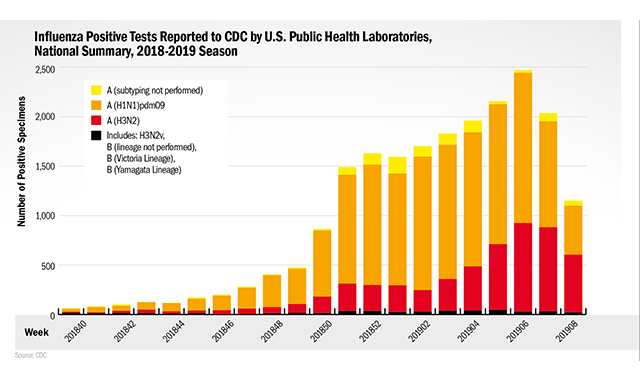New Research Aims to Combat Flu Pandemics
Researchers targeting virus' receptors used to enter the body.

Influenza Positive Tests Reported to CDC by U.S. Public Health Laboratories, National Summary, 2018-2019 Season

Researchers are testing a novel method to combat potential new flu pandemics and to treat influenza. They are targeting the receptors on cells that the virus uses to gain entry to the body.
In a report published in the Jan. 25, 2019, issue of Journal of Immunology, researchers at the Liverpool School of Tropical Medicine in the United Kingdom explained how they engineered a part of an antibody to target the viral proteins that allow flu to mutate and become deadly.
New drugs to combat influenza are needed because influenza outbreaks account for between 300,000 and 650,000 respiratory deaths globally each year, mostly in children and the elderly, says study author Richard Pleass, PhD, professor and chair of parasite immunology at the school, in a statement.
“Better anti-influenza therapeutics are urgently needed. The transfer of antibodies from people recovering from influenza during the 1918 and 2009 pandemics reduced mortality from influenza by 50% and 26%, respectively.”
Influenza vaccines have limited public health impact during a pandemic, and current influenza vaccines are less effective than the vaccines used against other infectious diseases, Pleass tells Drug Topics.
Trending: Case Studies in Stability
“This is because influenza viruses that circulate in human and animal populations mutate two key viral surface proteins, hemagglutinin (HA) and neuraminidase (NA), thus allowing them to escape from protective antibodies produced through natural infection or vaccination.”
Both HA and NA target a sugar called sialic acid, found in abundance on the receptors of cells lining the mammalian respiratory tract, which the virus uses to gain entry into the body. The sialic acid-binding contacts on HA and NA do not mutate readily, otherwise the virus would not be able to infect human cells, Pleass says.
Pleass and colleagues engineered antibody Fc (fragment crystallizable) with enhanced sialic acid that target these conserved parts of both HA and NA, binding influenza viruses and blocking their interactions with human cells.
In addition to influenza viruses, these engineered biologicals may also be useful in the control of other pathogens, such as group B streptococci, Streptococcus pneumoniae, Mycoplasma genitalium, and Newcastle Disease Virus.
“To be useful, these antibody medicines (also called FLU-IVIG) need to be manufactured in advance of future epidemics, which is obviously problematic as there may be modest or little neutralizing activity against newly-emerging strains. Therefore, combinations of existing medicines, including FLU-IVIG, with sialic acid blockers could increase their efficacy while future-proofing against the next pandemic,” Pleass says.
While a new anti-influenza drug could be used as a preventative, it also can be beneficial after the infection starts. “Often what kills you with flu is the ensuing cytokine storm. By binding inhibitory receptors these molecules may dampen such effects,” he says.
People who die from influenza are most often killed by a bacterial pneumonia, Pleass says. “Interestingly, these bacteria, by nature of being sialylated, can bind directly to influenza viruses that facilitate their entry and spread in the body. These molecules may therefore block this interaction and thus help the body contain the bacteria that actually hasten your death when you have flu.”
Recent: Drug Spending Soared 18% in 2018
The modified Fc fragments are suitable both as clinical candidates and for large-scale manufacture, Pleass says. “Fc fragments are a well understood class of compound and have even been used to treat idiopathic thrombocytopenia in children. They are also straightforward to manufacture using existing antibody pipelines available for Chinese hamster ovary cells, the manufacturing workhorse of the pharmaceutical industry.”
The findings are “at a very early stage and much work still needs to be done before they make it to the clinic,” Pleass tells Drug Topics. The researchers need to test the molecules in relevant animal models to determine if they have any in vivo efficacy as well as their half-life, safety, pharmacokinetics, and other factors.
The Wellcome Trust provided funding for the research. “This is a fascinating project, and one which could have really far-reaching impact not only for influenza but as a platform technology to develop new medicines for many other diseases that are currently treated by antibodies,” says Sara Marshall, PhD, head of clinical and physiological Sciences at the Wellcome Trust.